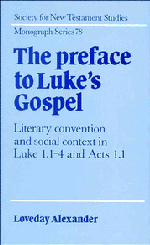Book contents
- Frontmatter
- Contents
- Acknowledgements
- Abbreviations
- 1 The Lucan preface: questions and assumptions
- 2 On the beginnings of books
- 3 Historical prefaces
- 4 Scientific prefaces: origins and development
- 5 Scientific prefaces: structure, content and style
- 6 Luke's preface
- 7 Prefaces in hellenistic Jewish literature
- 8 The social matrix of Luke's preface
- 9 The appropriate form of words for the occasion
- Appendix A Structural analysis of Luke 1.1–4 and selected scientific prefaces
- Appendix B Bibliographical notes on scientific prefaces
- Select bibliography
- Index of scientific authors
- Index of ancient authors and names
- Index of modern authors
- Index of subjects
5 - Scientific prefaces: structure, content and style
Published online by Cambridge University Press: 15 October 2009
- Frontmatter
- Contents
- Acknowledgements
- Abbreviations
- 1 The Lucan preface: questions and assumptions
- 2 On the beginnings of books
- 3 Historical prefaces
- 4 Scientific prefaces: origins and development
- 5 Scientific prefaces: structure, content and style
- 6 Luke's preface
- 7 Prefaces in hellenistic Jewish literature
- 8 The social matrix of Luke's preface
- 9 The appropriate form of words for the occasion
- Appendix A Structural analysis of Luke 1.1–4 and selected scientific prefaces
- Appendix B Bibliographical notes on scientific prefaces
- Select bibliography
- Index of scientific authors
- Index of ancient authors and names
- Index of modern authors
- Index of subjects
Summary
General characteristics
For our immediate purposes it is less important to discover the origins of the prefaces found in the scientific tradition than to determine whether it is possible to discern in them any kind of overall pattern. There is always a danger in this kind of analysis of imposing a false uniformity on the material; but in fact there are remarkable similarities in structure, in content and in style between the prefaces we are considering. Some display interests which in the nature of the case are limited to a particular subject, while others, especially the earlier ones, contain personal material which is necessarily unique; but overall it is not the differences which strike the reader so much as the similarities.
Three general tendencies are evident in the development of these prefaces. First, there is a marked tendency towards combination. We have already shown how elements pertaining to presentation (introduction, epilogue, summary and transition) appeared originally independently of, and prior to, dedication, but were taken up into dedicatory prefaces and combined with elements belonging properly to dedication. Similarly elements belonging properly to the beginning of the ‘systematic handbook’ (definition and division of the subject), which again had an independent and prior origin, came to be used among other preface-material in books whose organization is only vaguely ‘systematic’. So too with material reflecting the methodological discussion: our prefaces contain a number of allusions intelligible only as part of a wider and pre-existent debate (see below pp. 88–91).
- Type
- Chapter
- Information
- The Preface to Luke's Gospel , pp. 67 - 101Publisher: Cambridge University PressPrint publication year: 1993



